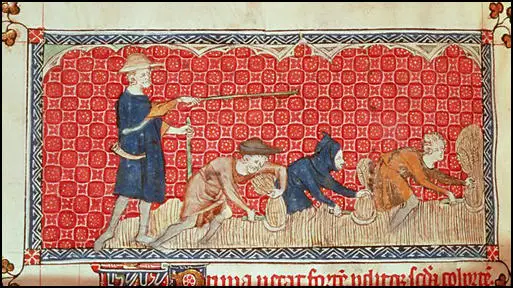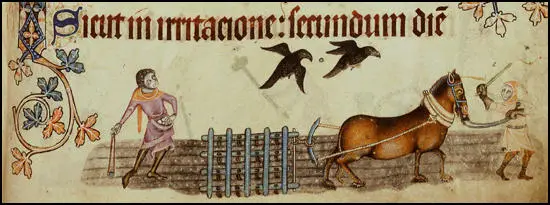Farming in the Middle Ages
Around most medieval villages there were three large arable fields. Two of these fields grew crops while the third was left fallow. The village would also have hay meadows and common land where the peasants had the right to graze their animals.
The three arable fields were divided into strips, each one being separated from the next by balks of unploughed land. To ensure that everybody had a fair share of the good land, each family was given strips in all three fields.
These strips were long and narrow because the peasants wanted to reduce to a minimum the number of times the plough-team had to turn round. On light soils a pair of oxen could successfully pull a plough. However, heavy clay soils needed a team of eight oxen. As most peasants only owned about two oxen they would have to join with others in order to have their land ploughed.
Medieval farmers preferred oxen to horses because they were less expensive to feed, stronger on heavy land and could be eaten when they died. The plough they used had an iron-tipped coulter in front to make the initial cut and a mould board to turn the soil over in a furrow. The fields were ploughed three times: the first turned the stubble over, the second removed the thistles and weeds and the third prepared the ground for sowing.

The three-field system of crop rotation was employed by medieval farmers, with spring as well as autumn sowings. Wheat or rye was planted in one field, and oats, barley, peas, lentils or broad beans were planted in the second field. The third field was left fallow. Each year the crops were rotated to leave one field fallow. This system also ensured that the same crop was not grown in the same field two years running.
Medieval farmers did what they could to increase the fertility of the land. They were aware that the soil would only give back as much as was put into it. Marl (a mixture of clay and carbonate of lime) and seaweed were used as fertilisers. Farmers knew that the best fertiliser was animal dung. However, small farmers could not afford the cost of feeding large numbers of animals and so manure was often in short supply.

The timing of the harvest in the Middle Ages was vitally important. If the wheat was too dry the grain would fall off. If it was too wet the grain would rot. To ensure that his own crops did not go to waste, the lord of the manor could demand extra labour services called boon-work during harvest time. Boon-work was hated by the villeins as it delayed their own harvesting and could cause their own crops to be ruined.
Despite the efforts of medieval farmers, their crop yields per acre amounted to only about a fifth of those achieved by farmers today. As villeins had to give about half their crop away as rent and taxes, they needed to farm a large area of land to provide an adequate diet for themselves. People dying of starvation was not unusual in the Middle Ages. This was especially true when bad weather led to a poor harvest.
Primary Sources
(1) Part of a song performed by medieval minstrels, The Husbandman Song (c. 1360)
To find money for the king I sold my seed.
Wherefore my land lies fallow and learns to sleep.
(2) Chronicle of Bury St Edmunds (1258)
There was a great shortage of everything because of the floods of the previous year, and corn, which was very scarce, cost from 15 shillings to as much as 20 shillings a quarter. Famine resulted so that the poor had to eat horse-meat, the bark of trees and even more unpleasant things. Many died of hunger.
(3) Walter of Henley, Fleta (c. 1275)
The Reeve, elected by the village to that office as the best manager... Let him therefore not be slothful or sleepy, but let him unceasingly strive for his lord's profit... When the dung is to be carried to the fields, let the Reeve stay with the carters, that they may labour and finish their day's work without trickery... Let the threshers and winnowing-women be closely spied upon, lest they steal corn in their shoes, gloves, bags or satchels hidden near the barn.
(4) Anonymous, The Reign of King Stephen (c. 1190)
In 1143... a terrible famine prevailed all over England... some, from lack of food, ate the forbidden flesh of dogs or horses... people wasted away and died in droves... You could have seen villages extremely well-known standing lonely and almost empty because the peasants of both sexes and all ages were dead.
(5) William Langland, The Vision of Piers Plowman (c. 1365)
Charged with children and overcharged by landlords, what they may spare they spend on milk/ or on meal to make porridge to still the sobbing of the children at meal time... The sadness of the women who live in these hovels is too sad to speak of or say in rhyme.
Student Activities
The Medieval Village Economy (Answer Commentary)
Women and Medieval Farming (Answer Commentary)
Contemporary Accounts of the Black Death (Answer Commentary)
Disease in the 14th Century (Answer Commentary)
King Harold II and Stamford Bridge (Answer Commentary)
The Battle of Hastings (Answer Commentary)
William the Conqueror (Answer Commentary)
The Feudal System (Answer Commentary)
The Domesday Survey (Answer Commentary)
Thomas Becket and Henry II (Answer Commentary)
Why was Thomas Becket Murdered? (Answer Commentary)
Illuminated Manuscripts in the Middle Ages (Answer Commentary)
